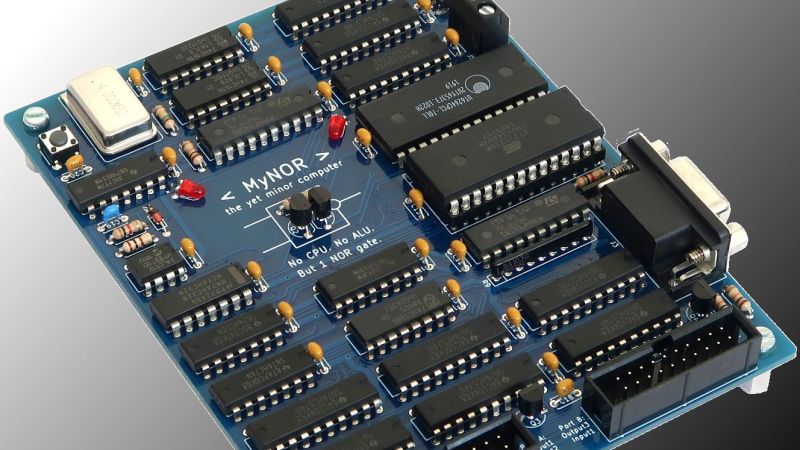We see a lot of discrete-logic computer builds these days, and we love them all. But after a while, they kind of all blend in with each other. So what’s the discrete logic aficionado to do if they want to stand out from the pack? Perhaps this CPU-less computer with a single NOR-gate instead of an arithmetic-logic unit is enough of a hacker flex? We certainly think so.
We must admit that when we first saw [Dennis Kuschel]’s “MyNor” we thought all the logic would be emulated by discrete NOR gates, which of course can be wired up in various combinations to produce every other logic gate. And while that would be really cool, [Dennis] chose another path. Sitting in the middle of the very nicely designed PCB is a small outcropping, a pair of discrete transistors and a single resistor. These form the NOR gate that is used, along with MyNor’s microcode, to perform all the operations normally done by the ALU.
While making the MyNor very slow, this has the advantage of not needing 74-series chips that are no longer manufactured, like the 74LS181 ALU. It may be slow, but as seen in the video below, with the help of a couple of add-on cards of similar architecture, it still manages to play Minesweeper and Tetris and acts as a decent calculator.
We really like the look of this build, and we congratulate [Dennis] on pulling it off. He has open-sourced everything, so feel free to build your own. Or, check out some of the other CPU-less computers we’ve featured: there’s the Gigatron, the Dis-Integrated 6502, or the jumper-wire jungle of this 8-bit CPU-less machine.















It is possible to build a CPU without a single gate: http://www.inf.fu-berlin.de/inst/ag-ki/rojas_home/documents/tutorials/SmallestCPU.pdf
Yes, of course it is possible to build a computer without a single gate for ALU functions. When I started developing MyNOR, I quickly found out that the gate is not really needed. It is possible to execute the logic function in microcode by simply using conditional branches. But this would slow down MyNOR even more, so it would be impossible to play games like Tetris or the car driving game I also wrote. Furthermore it looks nice when the two LEDs in the center of the board are blinking in time with the NOR operations ;-)
We should regard the NOR gate as a sort of hardware accelerator!
This is the reason why ALU have been invented ;-) . But without any gate used for computation and being a simple transfer machine, it is getting closer to a pure Turing machine.
I was working on something similar but the ALU only increments by 1. I suppose that can be implemented by a NOR gate, so maybe I was overthinking it.
I like it. Great project!
It is neat, and looks affordable too. Everyone talks about computing after the collapse but I don’t think anything with integrated circuits will be kept going due to parts scarcity. I’d say the dominant design will be a 1 bit disintegrated cpu. I’d love to see a project done like that.
That’s really cool! It does infuse a bit of magic into thow transistors and that resistor! Love the way they’re placed on the PCB.
Sooo, next up is… a 64 NOR gate version, to compete with them threadrippers? The NORipper ? :D
Others have said this but the board, the object itself, is beautiful!
This is an extreme version of a Reduced Instruction Set Computer (RISC) where there is only one instruction and everything else needs to be built using that. All the complexity would be in the stored program that would be encoded to exercise this single instruction to achieve the desired result.
Wonderful! Who will be the first to make it as a circuit sculpture?
Any one see a gap in the market for company for making jellybean’s pars and generic IC for hobby and electronic restoration base on the 74LS181 ALU are out of production line in the article?
How is the “non” CPU when the chips all come together to basically form a CPU?